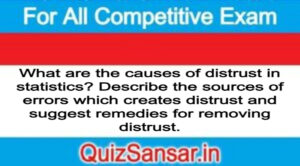
What are the causes of distrust in statistics? Describe the sources of errors which creates distrust and suggest remedies for removing distrust.
What are the causes of distrust in statistics? Describe the sources of errors which creates distrust and suggest remedies for removing distrust.
Or
What do you understand by distrust of statistics? Is the science of statistics to be blamed for it?
Or
Write a critical note on distrust of statistics. Discuss the important causes of distrust and show how statistics could be made reliable.
Ans.
Distrust of Statistics
Despite the indispensable usefulness and vital importance of statistics, it is looked upon with a suspicious eye. There are mutually diversified views for statistics by general people. Some persons say, “figures do not lie, conclusions drawn on the basis of figures, are authentic and true to the last.” Contrary to this some people are suspicious and hate statistics. According to them, it is a tissue of falsehood, statistics is rainbow of lies. “In the words of Disrateli, there are three degree of lies, dammned lies and statistics.” Darrell Huff remarked in an ironically language. “A well-wrapped statistics is better than Hitlar’s big-lie, it misleads, yet it cannot be pinned on you. “Stephen Leacock once wrote”, In earlier times, they had no statistics, and so they had to fall back on lies. Hence the huge exaggregations of primitive literature – giants or miracles or wonders! They did it with lies and we do it with statistics, but it is all the same”.
According to La Guardia, “Statistics are like alienists – they will testify to either side.” or “Statistics can prove anything’. On the basis of data, party in power can prove that during five years of planning in India, all round developments of the country has been made. While parties in opposition can prove that during five year planning period, the position of general mass has very much detoriated. In fact, “data are a very strong source which can be misused to prove lies as truth and truth as lies”. In the words of Darrell Huff, “the secret language of statistics, so appealing in a fact-minded culture, is employed to sensationalise, inflate, confuse and oversimplify.” Hence figures are distrusted. Figures which support a particular statement may be untrue, incomplete, inaccurate, manipulated by biased persons who wish to present a false picture to achieve particular objective. Later on, when they come to know that statistical statement has belied their faith, they start condemning it strongly and lose faith in it. A common man is not in a position to differentiate between correct and incorrect conclusions or interpretations.
Causes of Distrust
The following are the principal reasons of distrust in statistics :
(1) Ignorance of common people : Generally, people accept the statements expressed with figures without any argument. They think that if figures say so, it cannot be otherwise. Since figures never tell lies. During the course of time when they come to know the real position, different from the conclusions drawn by the data, they start abusing data because it causes distrust in them.
(2) Ignoring the limitations of Statistics : There are certain limitations of statistics. For example, statistical method is not the only method to study a problem, statistical conclusions are not applicable to individual items, statistical conclusions can be misleading without reference etc. To test the accuracy of data on individual units without referring to its limitations, shall give fallacious conclusions. Such ignorance leads to distrust in statistics.
(3) Lack of specialised Knowledge : For drawing conclusions from the collected data, specialised knowledge, ability and experience are needed. If the investigator or statistician does not posses these qualities, wrong and fallacious conclusions could be drawn, which will lead to distrust in statistics.
(4) Lack of test for Correctness of data : Sometimes wrong and inaccurate data are collected and inferences are drawn on the basis of these data. It cannot be identified by general people. A wrong table drawn according to the imagination of a general person is treated by him as important as is prepared by expert statisticians with hard labour on the basis of satisfactory data. It is very difficult to identify it. Thus different persons always have doubt and suspicion for the data.
(5) Misuse of Data: The investigator misuse the data with certain pre-conceived notions to serve his own ends. Sometimes, vague and unrealistic inferences are drawn, the result of which is that the belief of common man is belied and he starts disbelieving data.
Remedies for removing Distrust
To check the growing distrust towards statistics, certain precautions can be taken which are as under:
(1) Awareness Towards Limitations of Statistics : While interpreting statistics or data we should not be careless towards its limitations which may result in a state of confusion. The facts regarding homogeneousness and uniformity, with reference to the context etc. should be taken into consideration before operating upon them.
(2) Judicious Use of Data : According to Mills, “As a tool. statistical method requires intelligent usage and the results secured through statistical analysis require intelligent interpretations.”
One should not fully depend upon data. It is rightly said that “Statistics should not be used as a blind man does a lamp-post for support instead of for illumination. Therefore, the use of statistics should be made with caution and rational and not casually or abruptly or negligently.
(3) Self-Restraint: In the words of Yule and Kendall, “Statistics is one of those sciences whose adepts must exercise the self-restraint of an artists.” The statistician, therefore, has to act as an artist too. He must be unbiased and self-Restrained, otherwise there is always a danger of one-sided and biassedness Conclusions being drawn, which may give incentive to distrust in statistics.
(4) Clear and Independent Discussions : Statistical conclusions should be drawn after clear thinking and unbiased analysis. According to Wallis and Roberts Statistical interpretation depends not only or statistical ideas, but also on ordinary clear thinking. Clear thinking is n only indispensable in interpreting statistics, but is often sufficient even in the absence of specific statistical knowledge.” Many statistical misunderstandings are removed by independent and clear discussions.
(5) Other Precautions : While using statistical data it is necessary to take precaution at each step. Its proper methods have been used in unbiased manner right from the stage of collection of data to analysis and interpretation; hence there will hardly be any scope of data being misused.






